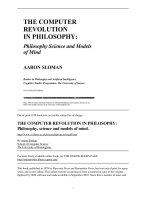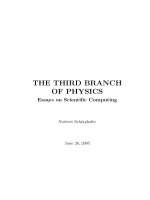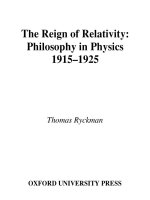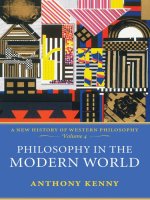- Trang chủ >>
- Khoa Học Tự Nhiên >>
- Vật lý
The modern revolution in physics
Bạn đang xem bản rút gọn của tài liệu. Xem và tải ngay bản đầy đủ của tài liệu tại đây (4.75 MB, 138 trang )
Book 6 in the Light and Matter series of free introductory physics textbooks
www.lightandmatter.com
www.pdfgrip.com
www.pdfgrip.com
The Light and Matter series of
introductory physics textbooks:
1
2
3
4
5
6
Newtonian Physics
Conservation Laws
Vibrations and Waves
Electricity and Magnetism
Optics
The Modern Revolution in Physics
www.pdfgrip.com
Benjamin Crowell
www.lightandmatter.com
www.pdfgrip.com
Fullerton, California
www.lightandmatter.com
copyright 1998-2003 Benjamin Crowell
edition 3.0
rev. 29th September 2006
This book is licensed under the Creative Commons Attribution-ShareAlike license, version 1.0,
except
for those photographs and drawings of which I am not
the author, as listed in the photo credits. If you agree
to the license, it grants you certain privileges that you
would not otherwise have, such as the right to copy the
book, or download the digital version free of charge from
www.lightandmatter.com. At your option, you may also
copy this book under the GNU Free Documentation
License version 1.2, />with no invariant sections, no front-cover texts, and no
back-cover texts.
ISBN 0-9704670-6-0
www.pdfgrip.com
To Gretchen.
www.pdfgrip.com
www.pdfgrip.com
Brief Contents
1
2
3
4
5
Relativity 13
Rules of Randomness 43
Light as a Particle 67
Matter as a Wave 85
The Atom 111
www.pdfgrip.com
Contents
2 Rules of Randomness
2.1 Randomness Isn’t Random . . . .
2.2 Calculating Randomness . . . . .
45
46
Statistical independence, 46.—Addition of
probabilities, 47.—Normalization, 48.—
Averages, 48.
2.3 Probability Distributions . . . . .
50
Average and width of a probability
distribution, 51.
.
.
.
.
53
58
60
62
3.1 Evidence for Light as a Particle . .
3.2 How Much Light Is One Photon?. .
68
71
2.4 Exponential Decay and Half-Life .
2.5 Applications of Calculus . . .
Summary . . . . . . . . . . . .
Problems . . . . . . . . . . . .
1 Relativity
1.1 The Principle of Relativity. . . . .
14
1.2 Distortion of Time and Space . . .
18
Time, 18.—Space, 20.—No simultaneity,
20.—Applications, 22.
1.3 Dynamics . . . . . . . . . . .
27
Combination
of
velocities,
27.—
Momentum, 28.—Equivalence of mass and
energy, 31.
Summary . . . . . . . . . . . . .
37
Problems . . . . . . . . . . . . .
39
3 Light as a Particle
The photoelectric effect, 71.—An unexpected dependence on frequency, 71.—
Numerical relationship between energy and
frequency, 73.
3.3 Wave-Particle Duality . . . . . .
A wrong interpretation: photons interfering with each other, 77.—The concept
10
www.pdfgrip.com
76
5 The Atom
of a photon’s path is undefined., 77.—
Another wrong interpretation: the pilot wave hypothesis, 78.—The probability
interpretation, 78.
3.4 Photons in Three Dimensions . . .
Summary . . . . . . . . . . . . .
Problems . . . . . . . . . . . . .
81
82
83
5.1 Classifying States . . . . . . . . 112
5.2 Angular
Momentum
in
Three
Dimensions . . . . . . . . . . . . 113
Three-dimensional angular momentum in
classical physics, 113.—Three-dimensional
angular momentum in quantum physics,
114.
5.3 The Hydrogen Atom . . . . . . . 115
5.4 Energies of States in Hydrogen . 117
5.5 Electron Spin . . . . . . . . . . 120
5.6 Atoms With More Than One Electron 121
Deriving the periodic table, 122.
Summary . . . . . . . . . . . . . 124
Problems . . . . . . . . . . . . . 126
4 Matter as a Wave
4.1 Electrons as Waves . . . . . . .
86
What kind of wave is it?, 89.
4.2
Dispersive Waves . . . . . .
4.3 Bound States . . . . . . . . . .
4.4 The Uncertainty Principle . . . . .
91
93
96
The
uncertainty
principle,
96.
Measurement and Schră
odingers cat, 100.
4.5 Electrons in Electric Fields . . . . 101
Tunneling, 102.
ă
4.6
The Schrodinger
Equation . . . 102
Summary . . . . . . . . . . . . . 106
Problems . . . . . . . . . . . . . 108
Appendix 1: Exercises 129
Appendix 2: Photo Credits 131
Appendix 3: Hints and Solutions 132
11
www.pdfgrip.com
www.pdfgrip.com
Chapter 1
Relativity
Complaining about the educational system is a national sport among
professors in the U.S., and I, like my colleagues, am often tempted
to imagine a golden age of education in our country’s past, or to
compare our system unfavorably with foreign ones. Reality intrudes,
however, when my immigrant students recount the overemphasis on
rote memorization in their native countries, and the philosophy that
what the teacher says is always right, even when it’s wrong.
Albert Einstein’s education in late-nineteenth-century Germany
was neither modern nor liberal. He did well in the early grades,1
but in high school and college he began to get in trouble for what
today’s edspeak calls “critical thinking.”
Indeed, there was much that deserved criticism in the state of
physics at that time. There was a subtle contradiction between the
theory of light as a wave and Galileo’s principle that all motion
is relative. As a teenager, Einstein began thinking about this on
an intuitive basis, trying to imagine what a light beam would look
like if you could ride along beside it on a motorcycle at the speed
of light. Today we remember him most of all for his radical and
far-reaching solution to this contradiction, his theory of relativity,
but in his student years his insights were greeted with derision from
his professors. One called him a “lazy dog.” Einstein’s distaste
for authority was typified by his decision as a teenager to renounce
his German citizenship and become a stateless person, based purely
on his opposition to the militarism and repressiveness of German
society. He spent his most productive scientific years in Switzerland
and Berlin, first as a patent clerk but later as a university professor.
He was an outspoken pacifist and a stubborn opponent of World
War I, shielded from retribution by his eventual acquisition of Swiss
citizenship.
a / Albert Einstein.
As the epochal nature of his work became evident, some liberal
Germans began to point to him as a model of the “new German,”
but after the Nazi coup d’etat, staged public meetings began, at
which Nazi scientists criticized the work of this ethnically Jewish
(but spiritually nonconformist) giant of science. When Hitler was
appointed chancellor, Einstein was on a stint as a visiting professor
at Caltech, and he never returned to the Nazi state. World War
1
The myth that he failed his elementary-school classes comes from a misunderstanding based on a reversal of the German numerical grading scale.
13
www.pdfgrip.com
b / The first nuclear explosion on our planet, Alamogordo,
New Mexico, July 16, 1945.
II convinced Einstein to soften his strict pacifist stance, and he
signed a secret letter to President Roosevelt urging research into
the building of a nuclear bomb, a device that could not have been
imagined without his theory of relativity. He later wrote, however,
that when Hiroshima and Nagasaki were bombed, it made him wish
he could burn off his own fingers for having signed the letter.
Einstein has become a kind of scientific Santa Claus figure in
popular culture, which is presumably why the public is always so titillated by his well-documented career as a skirt-chaser and unfaithful
husband. Many are also surprised by his lifelong commitment to socialism. A favorite target of J. Edgar Hoover’s paranoia, Einstein
had his phone tapped, his garbage searched, and his mail illegally
opened. A censored version of his 1800-page FBI file was obtained
in 1983 under the Freedom of Information Act, and a more complete version was disclosed recently.2 It includes comments solicited
from anti-Semitic and pro-Nazi informants, as well as statements,
from sources who turned out to be mental patients, that Einstein
had invented a death ray and a robot that could control the human
mind. Even today, an FBI web page3 accuses him of working for
or belonging to 34 “communist-front” organizations, apparently including the American Crusade Against Lynching. At the height of
the McCarthy witch hunt, Einstein bravely denounced McCarthy,
and publicly urged its targets to refuse to testify before the House
Unamerican Activities Committee. Belying his other-worldly and
absent-minded image, his political positions seem in retrospect not
to have been at all clouded by naivete or the more fuzzy-minded
variety of idealism. He worked against racism in the U.S. long before the civil rights movement got under way. In an era when many
leftists were only too eager to apologize for Stalinism, he opposed it
consistently.
This chapter is specifically about Einstein’s theory of relativity, but Einstein also began a second, parallel revolution in physics
known as the quantum theory, which stated, among other things,
that certain processes in nature are inescapably random. Ironically,
Einstein was an outspoken doubter of the new quantum ideas that
were built on his foundations, being convinced that “the Old One
[God] does not play dice with the universe,” but quantum and relativistic concepts are now thoroughly intertwined in physics.
1.1 The Principle of Relativity
By the time Einstein was born, it had already been two centuries
since physicists had accepted Galileo’s principle of inertia. One way
of stating this principle is that experiments with material objects
don’t come out any different due the straight-line, constant-speed
2
3
14
Chapter 1
Fred Jerome, The Einstein File, St. Martin’s Press, 2002
/>
Relativity
www.pdfgrip.com
motion of the apparatus. For instance, if you toss a ball up in the
air while riding in a jet plane, nothing unusual happens; the ball
just falls back into your hand. Motion is relative. From your point
of view, the jet is standing still while the farms and cities pass by
underneath.
The teenage Einstein was suspicious because his professors said
light waves obeyed an entirely different set of rules than material
objects, and in particular that light did not obey the principle of
inertia. They believed that light waves were a vibration of a mysterious substance called the ether, and that the speed of light should
be interpreted as a speed relative to this ether. Thus although the
cornerstone of the study of matter had for two centuries been the
idea that motion is relative, the science of light seemed to contain
a concept that a certain frame of reference was in an absolute state
of rest with respect to the ether, and was therefore to be preferred
over moving frames.
Experiments, however, failed to detect this mysterious ether.
Apparently it surrounded everything, and even penetrated inside
physical objects; if light was a wave vibrating through the ether,
then apparently there was ether inside window glass or the human
eye. It was also surprisingly difficult to get a grip on this ether.
Light can also travel through a vacuum (as when sunlight comes to
the earth through outer space), so ether, it seemed, was immune to
vacuum pumps.
Einstein decided that none of this made sense. If the ether was
impossible to detect or manipulate, one might as well say it didn’t
exist at all. If the ether doesn’t exist, then what does it mean when
our experiments show that light has a certain speed, 3 × 108 meters
per second? What is this speed relative to? Could we, at least in
theory, get on the motorcycle of Einstein’s teenage daydreams, and
travel alongside a beam of light? In this frame of reference, the
beam’s speed would be zero, but all experiments seemed to show
that the speed of light always came out the same, 3 × 108 m/s.
Einstein decided that the speed of light was dictated by the laws of
physics (the ones concerning electromagnetic induction), so it must
be the same in all frames of reference. This put both light and
matter on the same footing: both obeyed laws of physics that were
the same in all frames of reference.
the principle of relativity
Experiments don’t come out different due to the straight-line,
constant-speed motion of the apparatus. This includes both light
and matter.
This is almost the same as Galileo’s principle of inertia, except that
Section 1.1
www.pdfgrip.com
The Principle of Relativity
15
we explicitly state that it applies to light as well.
c / Albert Michelson, in 1887,
the year of the Michelson-Morley
experiment.
d / George
1901.
FitzGerald,
1851-
This is hard to swallow. If a dog is running away from me at 5
m/s relative to the sidewalk, and I run after it at 3 m/s, the dog’s
velocity in my frame of reference is 2 m/s. According to everything
we have learned about motion, the dog must have different speeds
in the two frames: 5 m/s in the sidewalk’s frame and 2 m/s in mine.
How, then, can a beam of light have the same speed as seen by
someone who is chasing the beam?
In fact the strange constancy of the speed of light had already
shown up in the now-famous Michelson-Morley experiment of 1887.
Michelson and Morley set up a clever apparatus to measure any
difference in the speed of light beams traveling east-west and northsouth. The motion of the earth around the sun at 110,000 km/hour
(about 0.01% of the speed of light) is to our west during the day.
Michelson and Morley believed in the ether hypothesis, so they expected that the speed of light would be a fixed value relative to the
ether. As the earth moved through the ether, they thought they
would observe an effect on the velocity of light along an east-west
line. For instance, if they released a beam of light in a westward direction during the day, they expected that it would move away from
them at less than the normal speed because the earth was chasing
it through the ether. They were surprised when they found that the
expected 0.01% change in the speed of light did not occur.
Although the Michelson-Morley experiment was nearly two decades in the past by the time Einstein published his first paper on
relativity in 1905, he probably did not even know of the experiment
until after submitting the paper.4 At this time he was still working
at the Swiss patent office, and was isolated from the mainstream of
physics.
How did Einstein explain this strange refusal of light waves to
obey the usual rules of addition and subtraction of velocities due to
relative motion? He had the originality and bravery to suggest a
radical solution. He decided that space and time must be stretched
and compressed as seen by observers in different frames of reference.
Since velocity equals distance divided by time, an appropriate distortion of time and space could cause the speed of light to come
4
e / Hendrik Lorentz, 1853-1928.
16
Chapter 1
Actually there is some controversy on this historical point. The experiment
in any case remained controversial until 40 years after it was first performed.
Michelson and Morley themselves were uncertain about whether the result was
to be trusted, or whether systematic and random errors were masking a real
effect from the ether. There were a variety of competing theories, each of which
could claim some support from the shaky data. For example, some physicists
believed that the ether could be dragged along by matter moving through it,
which inspired variations on the experiment that were conducted in tents with
thin canvas walls, or with part of the apparatus surrounded by massive lead
walls.
Relativity
www.pdfgrip.com
out the same in a moving frame. This conclusion could have been
reached by the physicists of two generations before, but the attitudes
about absolute space and time stated by Newton were so strongly
ingrained that such a radical approach didn’t occur to anyone before Einstein. In fact, George FitzGerald had suggested that the
negative result of the Michelson-Morley experiment could be explained if the earth, and every physical object on its surface, was
contracted slightly by the strain of the earth’s motion through the
ether, and Hendrik Lorentz had worked out the relevant mathematics, but they had not had the crucial insight that this it was space
and time themselves that were being distorted, rather than physical
objects.5
5
See discussion question F on page 26, and homework problem 12
Section 1.1
www.pdfgrip.com
The Principle of Relativity
17
1.2 Distortion of Time and Space
Time
Consider the situation shown in figure f. Aboard a rocket ship we
have a tube with mirrors at the ends. If we let off a flash of light at
the bottom of the tube, it will be reflected back and forth between
the top and bottom. It can be used as a clock; by counting the
number of times the light goes back and forth we get an indication
of how much time has passed: up-down up-down, tick-tock ticktock. (This may not seem very practical, but a real atomic clock
does work on essentially the same principle.) Now imagine that the
rocket is cruising at a significant fraction of the speed of light relative
to the earth. Motion is relative, so for a person inside the rocket,
f/1, there is no detectable change in the behavior of the clock, just
as a person on a jet plane can toss a ball up and down without
noticing anything unusual. But to an observer in the earth’s frame
of reference, the light appears to take a zigzag path through space,
f/2, increasing the distance the light has to travel.
f / A light beam bounces between
two mirrors in a spaceship.
If we didn’t believe in the principle of relativity, we could say
that the light just goes faster according to the earthbound observer.
Indeed, this would be correct if the speeds were much less than the
speed of light, and if the thing traveling back and forth was, say,
a ping-pong ball. But according to the principle of relativity, the
speed of light must be the same in both frames of reference. We are
forced to conclude that time is distorted, and the light-clock appears
to run more slowly than normal as seen by the earthbound observer.
In general, a clock appears to run most quickly for observers who
are in the same state of motion as the clock, and runs more slowly
as perceived by observers who are moving relative to the clock.
We can easily calculate the size of this time-distortion effect. In
the frame of reference shown in figure f/1, moving with the space-
18
Chapter 1
Relativity
www.pdfgrip.com
ship, let t be the time required for the beam of light to move from the
bottom to the top. An observer on the earth, who sees the situation
shown in figure f/2, disagrees, and says this motion took a longer
time T (a bigger letter for the bigger time). Let v be the velocity
of the spaceship relative to the earth. In frame 2, the light beam
travels along the hypotenuse of a right triangle, figure g, whose base
has length
base = vT
.
Observers in the two frames of reference agree on the vertical distance traveled by the beam, i.e., the height of the triangle perceived
in frame 2, and an observer in frame 1 says that this height is the
distance covered by a light beam in time t, so the height is
height = ct
,
where c is the speed of light. The hypotenuse of this triangle is the
distance the light travels in frame 2,
hypotenuse = cT
.
Using the Pythagorean theorem, we can relate these three quantities,
(cT )2 = (vT )2 + (ct)2
,
and solving for T , we find
T =
t
.
2
1 − (v/c)
The amount of distortion is given by the factor 1/ 1 − (v/c)2 ,
and this quantity appears so often that we give it a special name, γ
(Greek letter gamma),
1
γ=
.
2
1 − (v/c)
self-check A
What is γ when v = 0? What does this mean?
g / One observer says the
light went a distance cT , while
the other says it only had to travel
ct.
Answer, p. 132
We are used to thinking of time as absolute and universal, so it
is disturbing to find that it can flow at a different rate for observers
in different frames of reference. But consider the behavior of the γ
factor shown in figure h. The graph is extremely flat at low speeds,
and even at 20% of the speed of light, it is difficult to see anything
happening to γ. In everyday life, we never experience speeds that
are more than a tiny fraction of the speed of light, so this strange
strange relativistic effect involving time is extremely small. This
makes sense: Newton’s laws have already been thoroughly tested
by experiments at such speeds, so a new theory like relativity must
agree with the old one in their realm of common applicability. This
requirement of backwards-compatibility is known as the correspondence principle.
Section 1.2
www.pdfgrip.com
Distortion of Time and Space
19
h / The behavior of the γ factor.
Space
The speed of light is supposed to be the same in all frames of reference, and a speed is a distance divided by a time. We can’t change
time without changing distance, since then the speed couldn’t come
out the same. If time is distorted by a factor of γ, then lengths must
also be distorted according to the same ratio. An object in motion
appears longest to someone who is at rest with respect to it, and is
shortened along the direction of motion as seen by other observers.
No simultaneity
Part of the concept of absolute time was the assumption that it
was valid to say things like, “I wonder what my uncle in Beijing is
doing right now.” In the nonrelativistic world-view, clocks in Los
Angeles and Beijing could be synchronized and stay synchronized,
so we could unambiguously define the concept of things happening
simultaneously in different places. It is easy to find examples, however, where events that seem to be simultaneous in one frame of
reference are not simultaneous in another frame. In figure i, a flash
of light is set off in the center of the rocket’s cargo hold. According
to a passenger on the rocket, the parts of the light traveling forward and backward have equal distances to travel to reach the front
and back walls, so they get there simultaneously. But an outside
observer who sees the rocket cruising by at high speed will see the
20
Chapter 1
Relativity
www.pdfgrip.com
flash hit the back wall first, because the wall is rushing up to meet
it, and the forward-going part of the flash hit the front wall later,
because the wall was running away from it.
i / Different observers don’t agree
that the flashes of light hit the
front and back of the ship simultaneously.
We conclude that simultaneity is not a well-defined concept.
This idea may be easier to accept if we compare time with space.
Even in plain old Galilean relativity, points in space have no identity of their own: you may think that two events happened at the
same point in space, but anyone else in a differently moving frame
of reference says they happened at different points in space. For
instance, suppose you tap your knuckles on your desk right now,
count to five, and then do it again. In your frame of reference, the
taps happened at the same location in space, but according to an
observer on Mars, your desk was on the surface of a planet hurtling
through space at high speed, and the second tap was hundreds of
kilometers away from the first.
Relativity says that time is the same way — both simultaneity
and “simulplaceity” are meaningless concepts. Only when the relative velocity of two frames is small compared to the speed of light
will observers in those frames agree on the simultaneity of events.
j / In the garage’s frame of reference, 1, the bus is moving, and
can fit in the garage. In the bus’s
frame of reference, the garage is
moving, and can’t hold the bus.
The garage paradox
One of the most famous of all the so-called relativity paradoxes
has to do with our incorrect feeling that simultaneity is well defined.
The idea is that one could take a schoolbus and drive it at relativistic
speeds into a garage of ordinary size, in which it normally would not
fit. Because of the length contraction, the bus would supposedly fit
Section 1.2
www.pdfgrip.com
Distortion of Time and Space
21
in the garage. The paradox arises when we shut the door and then
quickly slam on the brakes of the bus. An observer in the garage’s
frame of reference will claim that the bus fit in the garage because of
its contracted length. The driver, however, will perceive the garage
as being contracted and thus even less able to contain the bus. The
paradox is resolved when we recognize that the concept of fitting the
bus in the garage “all at once” contains a hidden assumption, the
assumption that it makes sense to ask whether the front and back of
the bus can simultaneously be in the garage. Observers in different
frames of reference moving at high relative speeds do not necessarily
agree on whether things happen simultaneously. The person in the
garage’s frame can shut the door at an instant he perceives to be
simultaneous with the front bumper’s arrival at the back wall of the
garage, but the driver would not agree about the simultaneity of
these two events, and would perceive the door as having shut long
after she plowed through the back wall.
Applications
Nothing can go faster than the speed of light.
What happens if we want to send a rocket ship√off at, say, twice
the speed of light, v = 2c? Then γ will be 1/ −3. But your
math teacher has always cautioned you about the severe penalties
for taking the square root of a negative number. The result would
be physically meaningless, so we conclude that no object can travel
faster than the speed of light. Even travel exactly at the speed of
light appears to be ruled out for material objects, since γ would
then be infinite.
Einstein had therefore found a solution to his original paradox
about riding on a motorcycle alongside a beam of light. The paradox
is resolved because it is impossible for the motorcycle to travel at
the speed of light.
Most people, when told that nothing can go faster than the speed
of light, immediately begin to imagine methods of violating the rule.
For instance, it would seem that by applying a constant force to an
object for a long time, we could give it a constant acceleration,
which would eventually make it go faster than the speed of light.
We’ll take up these issues in section 1.3.
Cosmic-ray muons
A classic experiment to demonstrate time distortion uses observations of cosmic rays. Cosmic rays are protons and other atomic nuclei from outer space. When a cosmic ray happens to come the way
of our planet, the first earth-matter it encounters is an air molecule
in the upper atmosphere. This collision then creates a shower of
particles that cascade downward and can often be detected at the
earth’s surface. One of the more exotic particles created in these cosmic ray showers is the muon (named after the Greek letter mu, µ).
22
Chapter 1
Relativity
www.pdfgrip.com
The reason muons are not a normal part of our environment is that
a muon is radioactive, lasting only 2.2 microseconds on the average
before changing itself into an electron and two neutrinos. A muon
can therefore be used as a sort of clock, albeit a self-destructing and
somewhat random one! Figures k and l show the average rate at
which a sample of muons decays, first for muons created at rest and
then for high-velocity muons created in cosmic-ray showers. The
second graph is found experimentally to be stretched out by a factor of about ten, which matches well with the prediction of relativity
theory:
γ = 1/
= 1/
1 − (v/c)2
1 − (0.995)2
k / Decay of
at rest with
observer.
≈ 10
muons created
respect to the
Since a muon takes many microseconds to pass through the atmosphere, the result is a marked increase in the number of muons that
reach the surface.
Time dilation for objects larger than the atomic scale
Our world is (fortunately) not full of human-scale objects moving at significant speeds compared to the speed of light. For this
reason, it took over 80 years after Einstein’s theory was published
before anyone could come up with a conclusive example of drastic
time dilation that wasn’t confined to cosmic rays or particle accelerators. Recently, however, astronomers have found definitive proof
that entire stars undergo time dilation. The universe is expanding
in the aftermath of the Big Bang, so in general everything in the
universe is getting farther away from everything else. One need only
find an astronomical process that takes a standard amount of time,
and then observe how long it appears to take when it occurs in a
part of the universe that is receding from us rapidly. A type of exploding star called a type Ia supernova fills the bill, and technology
is now sufficiently advanced to allow them to be detected across vast
distances. Figure m shows convincing evidence for time dilation in
the brightening and dimming of two distant supernovae.
l / Decay of muons moving at
a speed of 0.995c with respect to
the observer.
The twin paradox
A natural source of confusion in understanding the time-dilation
effect is summed up in the so-called twin paradox, which is not really
a paradox. Suppose there are two teenaged twins, and one stays at
home on earth while the other goes on a round trip in a spaceship at
Section 1.2
www.pdfgrip.com
Distortion of Time and Space
23
m / Light curves of supernovae,
showing a time-dilation effect for
supernovae that are in motion relative to us.
relativistic speeds (i.e., speeds comparable to the speed of light, for
which the effects predicted by the theory of relativity are important).
When the traveling twin gets home, she has aged only a few years,
while her sister is now old and gray. (Robert Heinlein even wrote
a science fiction novel on this topic, although it is not one of his
better stories.)
The “paradox” arises from an incorrect application of the principle of relativity to a description of the story from the traveling
twin’s point of view. From her point of view, the argument goes,
her homebody sister is the one who travels backward on the receding
earth, and then returns as the earth approaches the spaceship again,
while in the frame of reference fixed to the spaceship, the astronaut
twin is not moving at all. It would then seem that the twin on earth
is the one whose biological clock should tick more slowly, not the
one on the spaceship. The flaw in the reasoning is that the principle
of relativity only applies to frames that are in motion at constant
velocity relative to one another, i.e., inertial frames of reference.
The astronaut twin’s frame of reference, however, is noninertial, because her spaceship must accelerate when it leaves, decelerate when
it reaches its destination, and then repeat the whole process again
on the way home. Their experiences are not equivalent, because
the astronaut twin feels accelerations and decelerations. A correct
treatment requires some mathematical complication to deal with the
changing velocity of the astronaut twin, but the result is indeed that
it’s the traveling twin who is younger when they are reunited.6
6
Readers frequently wonder why the effects of the decelerations don’t cancel
out the effects of the accelerations. There are a couple of subtle issues here. First,
there’s no clearcut way to decide whether the time distortion happens during
the accelerations and decelerations, or during the long periods of constant-speed
cruising in between. This is because simultaneity isn’t well defined, so there’s no
well-defined answer if Earth-bound Emma asks, “Is my sister’s time distorted
right now ?” During the long period when spacefaring Sarah is cruising away
from Earth at constant speed, Emma may observe that her sister’s voice on
24
Chapter 1
Relativity
www.pdfgrip.com
The twin “paradox” really isn’t a paradox at all. It may even be
a part of your ordinary life. The effect was first verified experimentally by synchronizing two atomic clocks in the same room, and then
sending one for a round trip on a passenger jet. (They bought the
clock its own ticket and put it in its own seat.) The clocks disagreed
when the traveling one got back, and the discrepancy was exactly
the amount predicted by relativity. The effects are strong enough
to be important for making the global positioning system (GPS)
work correctly. If you’ve ever taken a GPS receiver with you on a
hiking trip, then you’ve used a device that has the twin “paradox”
programmed into its calculations. Your handheld GPS box gets signals from a satellite, and the satellite is moving fast enough that its
time dilation is an important effect. So far no astronauts have gone
fast enough to make time dilation a dramatic effect in terms of the
human lifetime. The effect on the Apollo astronauts, for instance,
was only a fraction of a second, since their speeds were still fairly
small compared to the speed of light. (As far as I know, none of the
astronauts had twin siblings back on earth!)
An example of length contraction
Figure n shows an artist’s rendering of the length contraction for
the collision of two gold nuclei at relativistic speeds in the RHIC accelerator in Long Island, New York, which went on line in 2000. The
gold nuclei would appear nearly spherical (or just slightly lengthened
like an American football) in frames moving along with them, but in
the laboratory’s frame, they both appear drastically foreshortened
as they approach the point of collision. The later pictures show the
nuclei merging to form a hot soup, in which experimenters hope to
observe a new form of matter.
the radio sounds abnormally slow, and conclude that the time distortion is in
progress. Sarah, however, says that she herself is normal, and that Emma is
the one who sounds slow. Each twin explains the other’s perceptions as being
due to the increasing separation between them, which causes the radio signals
to be delayed more and more. The other thing to understand is that, even if
we do decide to attribute the time distortion to the periods of acceleration and
deceleration, we should expect the time-distorting effects of accelerations and
decelerations to reinforce, not cancel. This is because there is no clear distinction
between acceleration and deceleration that can be agreed upon by observers in
different inertial frames. This is a fact about plain old Galilean relativity, not
Einstein’s relativity. Suppose a car is initially driving westward at 100 km/hr
relative to the asphalt, then slams on the brakes and stops completely. In the
asphalt’s frame of reference, this is a deceleration. But from the point of view
of an observer who is watching the earth rotate to the east, the asphalt may be
moving eastward at a speed of 1000 km/hr. This observer sees the brakes cause
an acceleration, from 900 km/hr to 1000 km/hr: the asphalt has pulled the car
forward, forcing car to match its velocity.
Section 1.2
www.pdfgrip.com
Distortion of Time and Space
25









